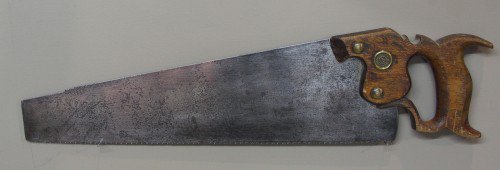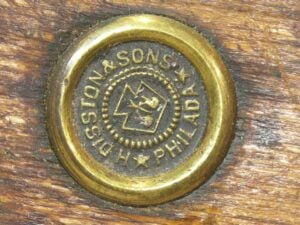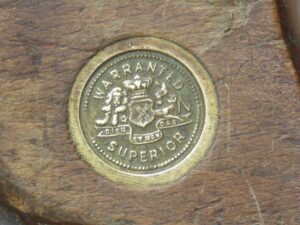A lovely Disston handsaw
A saw by any other name could cut as sweet
I have many favourite saws. One in each of the categories. You’ve seen them in past posts here on my blog. I don’t collect them. I can’t imagine the empty vanity in collecting good saws you don’t use to work work wood with. I want to wear out all of my saws, but it’s unlikely that I could even wear out one of my personal saws and here is the reason.
An eBay buy that turned out to be a very fine Gent’s hand ripsaw

Forty six years ago, as an apprentice, I bought a Spear & Jackson tenon saw, a Sandvik panel saw, a Disston rip saw and a Disston panel saw. I have used them since 1965, throughout my life as a working craftsman, (that means most days) sharpened them myself month after woodcutting month, and they are still have about two-thirds working steel left in them. I think that Sandvik was the best of the bunch as far as lasting simply because the steel was the best. As for the design, I still don’t care for the plastic handles, they make me sick to look at them really.
Sandvik was one of the first to disgard wooden handles and their first plastic handles with the dragon symbol was at least hand fitting. That says something for its company carbon footprint. It pioneered disposable saws by hardening the steel teeth and adding cheap plastic (spastic) handles under the more recent name of Bahco. It is the ultimate disposable saw. It doesn’t need to be, and we can do nothing about it as the company proved its superiority by being in control of what we buy. You see, all the joiners and carpenters I meet tell me that they no longer use “those old saws.” The buy ones that can be thrown away because, they reason, it’s now quicker easier and cheaper to, well, just buy another. They don’t see that they have been rendered impotent. They can’t sharpen saws anymore, they don’t know how. They don’t know a man can sharpen and set a saw in a few minutes and that a good saw will last a hundred years. Anyway, Sandvik’s assets are 90 billion and every carpenter and joiner thinks that they are wonderful because they don’t have to sharpen saws any more.
A Henry Disston No7 made circa 1848 and still being used by me in 2011

But look at this. This is a Disston saw. Look at the handle, the shape fits a man’s hand like the hand inside a glove. This saw was made to celebrate an event for Hammacher Schlemmer in New York in 1848.





Paul,
Following your advice, I have bought several
old Disstons that I am planning to restore. The problem is that when you
buy from E bay, you can’t tell about the small kinks, and twisting that
some of these came with.
I have been reading a blob
from a gentleman called Bob Smalser, on which he explains the process of
straightening damaged saws. Still, for a novice like me, the concepts
of “tensioning” and other metallurgic processes are difficult to
comprehend, and even more difficult to apply just after reading about
it.
I think it would be very useful if you could
produce a video addressing these issues, which are essential when your
trying to restore tools that were made a century ago.
Best personal regards,
Nelson Preschel
(the one that works with tiny tools inside people’s eyes)
Hi Paul,
How can I tell the difference between a rip saw and a cross cut saw when buying second hand?
regards
Ian
Looking at the side of the saw plate the teeth on the alternate teeth will have a slight bevel to the front and back of the teeth. This then results in a pinnacle point to the teeth. A ripcut saw will show just the profile of the teeth equally with no bevel.
Thank you so much for this post, I agree wholeheartedly. I recently had a saw handed down to me from my grandfather. Like yours on the top edge toward the tip it has the slight cut out with a little nub. What is that for? My only guess is that it helps clear material out when you bury the saw. Can you explain that feature?
Lots of theories through the past century but none that really make much sense, which, if you will allow me, includes cleaning out cuts as the saw deepens, marking start points and others. I even have my own practical application for it and in practice it works for me, but i haven’t seen anyone else do it.
I also have a Disston with the same marking. The plate comes to a very narrow point on the end. I found it hanging on a exposed wall, being used as a decoration. It was really ugly, and now it has become one of my favorites. I’m not sure what it’s original purpose was, but I use it for everything but small work.
Hi Paul. Would you mind checking this link to look at this Disston Philada saw (Trade me is NZ’s version of Ebay)? Do you think it is worth buying? 25 $ is about 12 £, so seems reasonable, but I wondered if the blade looks very worn/shallow. Thanks if you can help. Rob
It looks like a good saw and a good price and therefore a good buy to me. I would go for it.
Thanks Paul. Should be on its way to me soon!
My grandfather left 6 Disston panel saws. Three of them have 3 silver medallions that say Disston USA on the medallion. Are those good saws that Disston made? One says townsmen on the saw plate.
Michael: http://www.disstonianinstitute.com
I inherited 2 Diston saws from my Grandfather, who inherited them from his dad. Today with a little less fear, after reading your blog, and watching your videos, I resharpened the crosscut saw. After probably 30 years it has been placed back in service, with my very amateur hands. It cut well. There is enough steel left to hopefully go to my grandkids one day. My son is 3 and I’m so happy to have him standing next to me in the garage. Very seldom do I pull out a power tool. Mostly when I’m lazy or can’t figure out how to do it by hand, and almost fear the loud noisy cacophony it creates. In this quitter and safer work, I hope to bond with my son, the same way I bonded with my grandfather. Over the sounds of hand planes and that almost hypnotic rhythm of a saw through wood.
Like Renauld, I too have Just inherited disston saws from my grandfather , which were his dads’ saws ( my great grandfather). There are three altogether , a d-7 probably made in the 1940’s , a d-23 rip saw , and another disston saw that has a laminated handle that I cannot find any markings on , possibly a d-15. Being an advid woodworker my self , I cherish these saws., by the way my great grand father was a master carpenter.
Paul,
I am still using a 28″ D-8 Rip Saw c1920, a 22″ Panel c1930 and a 14″ No. 5 Carcass
Saw c1938 (I do cheat when out on site with a throwaway) however when in the shop
the above are used together with a S&J 26″ Spearior 88 from the 50’s purchased when I was an Apprentice.
Tony Leeding.
Judging from the medallion on your Disston handsaw it would have been made between 1896 and 1917. You can check for yourself if you consult the dating timeline on the Disstonian Institute website Here’s a link:
http://www.disstonianinstitute.com/medv2.html
Disston used flat filed split saw screws until 1870, before he changed over to the screws which are used on your saw.
2/9/2019 I bought a group of 14 handsaws. All need serious cleaning and sharpened. Five are Disston saws, one is a Sandvik with the plastic dragon handle, one is a Craftsman, a small saw from Oak Leaf, and an assortment that are still unknown. I have $100 USD in the saws, but the good ones seem straight and have little wear. There was another $50 in two braces and a set of 11 Irwin bits in serviceable condition a small block plane and what appears to be a Stanley handyman plane. There is a bit of rust and a serious need for oil and cleaning. This collection came from the estate of a WW2 veteran.
Hi Paul, Just discovered you and love your “how to” videos. Recently saw
Disston saw (price $75). It looked to be from 20 to 24 inches with a nice
handle and medalian. However the to edges of it, forward of the nub had teeth. The bottom looked to be a rip saw. have searched the net and found no saws like this. Any ideas? Maybe a home made improvement?
Thanks, dew